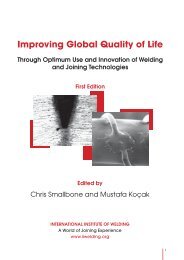The Comparison of Microstructure and Mechanical Properties of
The Comparison of Microstructure and Mechanical Properties of
The Comparison of Microstructure and Mechanical Properties of
You also want an ePaper? Increase the reach of your titles
YUMPU automatically turns print PDFs into web optimized ePapers that Google loves.
63 rd Annual Assembly & International Conference <strong>of</strong> the International Institute <strong>of</strong> Welding<br />
11-17 July 2010, Istanbul, Turkey<br />
AWST-10/100<br />
Among the rutile FCWs, G wire has the highest strength<br />
with 581 MPa. <strong>The</strong> other K, S <strong>and</strong> E rutile wires have<br />
tensile strength <strong>of</strong> 550 MPa, 550 MPa <strong>and</strong> 551 MPa,<br />
respectively. Beside this, B wire which is basic FCW has<br />
the highest tensile strength <strong>of</strong> 603 MPa. As shown in the<br />
Table 3, M wire has the lowest strength value with 513<br />
MPa. Figure 7 shows the tensile specimen ruptured from<br />
base metal <strong>of</strong> S wire <strong>and</strong> Figure 8 shows tensile strength<br />
values <strong>of</strong> the wires.<br />
Figure 9b. Root <strong>and</strong> facial images <strong>of</strong> one <strong>of</strong> the wires<br />
<strong>The</strong> impact toughness <strong>of</strong> the weld metals was evaluated<br />
by Charpy impact testing. Impact test results are seen in<br />
Table 1 <strong>and</strong> Figure 10 also shows the values <strong>of</strong> Charpy<br />
V-Notches parallel to the weld axis (Figure 2a) tested at<br />
-20ºC <strong>and</strong> 20 ºC for G, K, S, E, B <strong>and</strong> M FCWs.<br />
Figure 7. Tensile specimen <strong>of</strong> wire ruptured from base metal as a<br />
sample<br />
<strong>The</strong> charpy impact values at 20ºC <strong>and</strong> -20ºC indicate that<br />
maximum toughness was obtained for B wire, with 158<br />
joule at 20ºC <strong>and</strong> 88 joule at -20ºC. It is attributed to the<br />
low hardness showed in Table 3. E wire has also very<br />
low impact energy compared to other wires. It is known<br />
that when the hardness value increase, the impact<br />
toughness decreases. Thus, it is concluded that E wire,<br />
which has high hardness strength, shows brittle character<br />
so impact toughness decreases. E wire’s fine grain size<br />
also supports its high hardness. M wire also has the<br />
second highest value with 63 joule at -20ºC.<br />
As shown in the Table 3, K wire with 14 joule <strong>and</strong> G<br />
wire with 32 joule at -20 ºC have the lowest toughness<br />
value. It appears that the toughness values obtained one<br />
lower than the values which could be generally<br />
generated for low carbon structural steels.<br />
Figure 8. Tensile strength values <strong>of</strong> FCWs<br />
Bending results were given as bendability. It has not<br />
observed any problems during the bending tests <strong>of</strong> the<br />
wires. Figure 9a shows the bending specimen <strong>and</strong><br />
bending test machine. Figure 9b shows facial <strong>and</strong> root<br />
bend images <strong>of</strong> one <strong>of</strong> the wires.<br />
In this study, st 52, 3 grade steel was used <strong>and</strong> this has<br />
caused some degree <strong>of</strong> dilution into the weld metal <strong>and</strong><br />
has adversely affected the properties <strong>of</strong> the weld metal<br />
toughness values. However, the values obtained for the<br />
comparison reason can still be used for comparing the<br />
weldments.<br />
Figure 9a. Bending specimen image <strong>and</strong> bending test<br />
Figure 10. Charpy impact values <strong>of</strong> FCWs<br />
23
















